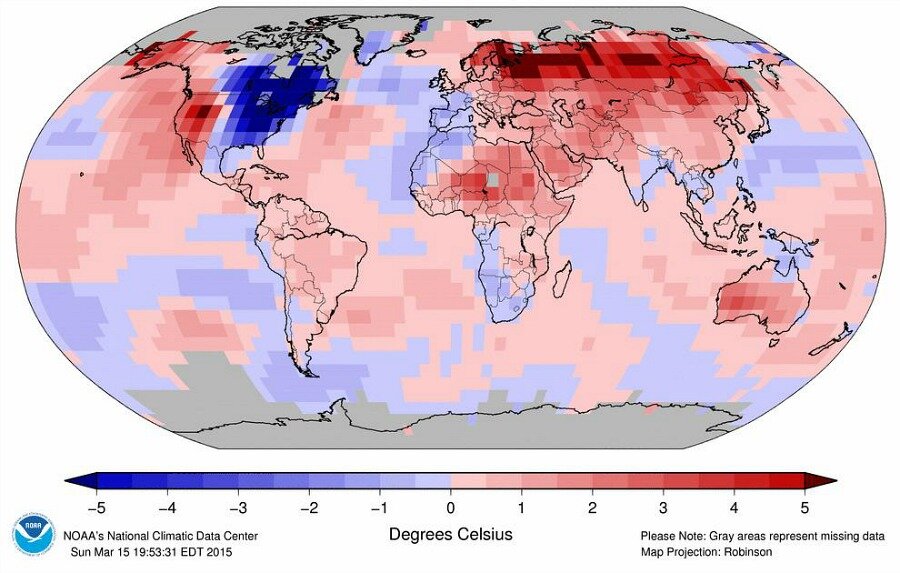Boston may not believe it, but it has been the warmest winter ever
Loading...
Bostonians still digging out from a record snow season may scoff at the news, but global temperatures for December through February were the warmest on record – which is saying something, since that goes back 135 years.
In fact, according to the National Oceanic and Atmospheric Administration’s report this week, global temperatures for the period could have been even higher but for cooler-than-average numbers across eastern North America (the United States and Canada).
Among other tidbits from NOAA’s report:
- From December to February, the average temperature across global land and ocean surfaces was 1.42 degrees Fahrenheit above the 20th century average – the highest for the three-month period in the 1880-2015 record, surpassing the previous record of 2007 by 0.05 degrees.
- Last month was the second warmest February on record. The average temperature across global land and ocean surfaces was 1.48 degrees F above the 20th century average, just a fraction below the 1998 record (1.55 degrees above average).
- The average Arctic sea ice extent for February was 370,000 square miles (6.2 percent) below the 1981-2010 average. This was the third smallest February extent since records began in 1979.
- Parts of Russia, Asia, Europe, Australia, Africa, South America, and especially the US West were extra warm. As a whole, the US had a bit-cooler-than-normal February, but slightly warmer-than-normal winter.
“In February 2015, cooler to much-cooler-than average conditions overtook the entire eastern half of the United States and the eastern third of Canada, with some record cold pockets seen around the Great Lakes region and part of northeastern Canada near Hudson Bay,” according to NOAA. “In stark contrast to the eastern United States, the western United States was encompassed by record warmth. The warm-cold pattern over the country has been observed over much of the past two years.”
But, says NOAA, “The majority of the world’s land surfaces … were warmer than average with much-warmer-than average temperatures widespread across Central America, northern and central South America, Australia, most of Africa, and much of Eurasia, including a broad swath that covered most of Russia.”
This winter has been so exceptionally and persistently warm across the western third of the United States that more than 20 cities have tied or broken all-time winter records, the Weather Channel reported earlier this month. (NOAA considers December-February as meteorological winter.)
All of which heightens the debate over climate change – which 97 percent of climate scientists (according to NASA) say has been dramatically influenced by human activities.
Still, the political situation is such – Republican skeptics run Congress, Democratic believers the White House – that a comprehensive and long-range plan to tackle global warming has yet to be passed.
Consequently, President Obama has issued some executive orders dealing with the root causes of climate change.
On Thursday, Obama signed an order requiring the federal government to cut greenhouse gas emissions by 40 percent by 2025 from 2008 levels while increasing the amount of renewable energy supplying electricity to federal facilities to 30 percent over the same period.
This will be the equivalent of taking 5.5 million cars off the road for a year, saving 26 million metric tons of greenhouse gas emissions in carbon dioxide-equivalent terms, according to the administration.
“With a footprint that includes 360,000 buildings, 650,000 fleet vehicles and $445 billion spent annually on goods and services, the federal government’s actions to reduce pollution, support renewable energy and operate more efficiently can make a significant impact on national emissions,” the White House said.
Administration officials estimate these moves could save as much as $18 billion over a decade, as efficiency improvements lower the amount of electricity agencies use. Still, federal agencies account for less than 1 percent of greenhouse gas emissions in the US.








